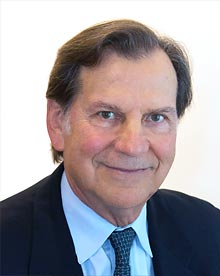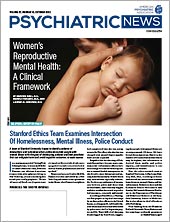While he was working as a first-year resident on an inpatient unit, one of Douglas G. Jacobs, M.D.’s, first patients attempted suicide. Fortunately, the patient was on a 15-minute suicide watch, so the staff intervened in time, and there was no lasting physical injury.
“The patient apologized and said they’d ‘been a bad patient.’ I assured the patient, ‘Absolutely not,’ but wondered in the back of mind if I’d been a bad doctor. I asked myself ‘How did this happen?’” Jacobs recalled in a recent interview with Psychiatric News. “Virtually every professional direction and every clinical contact I’ve had since then has been stimulated by that experience.”
In fact, Jacobs has dedicated his now 50-plus year career to improving the assessment and treatment of patients at risk for suicide and educating clinicians on the subject. Jacobs is an associate professor of psychiatry at Harvard Medical School and a member of the McLean Hospital Suicide Advisory Committee. In his private practice, he lets it be known that he is interested in and willing to work with individuals experiencing suicidality.
Over his career he has conducted research, written three textbooks on suicidality, led countless symposia on the subject, and spearheaded public education campaigns, including launching National Depression Screening Day in 1991. It has become an annual campaign, this year on October 6, to encourage schools, health care organizations, and others to stage mass depression screenings and include them as a routine part of health care.
Jacobs views this work as more important now than ever, given the 30% rise in the U.S. suicide rate over the past 20 years. His appointment as chair of the APA committee that developed the Practice Guideline for the Assessment and Treatment of Patients With Suicidal Behaviors was “the greatest professional honor of my career,” he said. An updated version of that guideline was woven into a subsection of APA’s Practice Guideline for the Psychiatric Evaluation of Adults, which was published in 2016. Together with colleagues, Jacobs also maintains on the McLean Hospital website a free clinician resource on suicide-focused assessment and treatment, periodically updated with the latest research findings.
Jacobs pointed out that among even the highest risk populations, such as individuals with serious mental illness, suicide is fortunately rare. Case in point: among adults who reported suicidal ideation and a plan for suicide, both major risk factors, 1.3% died by suicide in 2020, according to research by the Substance Abuse and Mental Health Services Administration (SAMHSA). However the effects of suicide ripple through populations, with 135 individuals on average affected by every death, research shows.
Research Shapes New Approaches
One major challenge psychiatrists face is that suicide cannot be predicted based on the presence of risk factors, either alone or in combination, Jacobs explained. Because prediction is not possible, the priority should be on assessing a person’s level of risk and immediate safety needs, and then deciding what treatment setting and plan would best meet those, he said. Also critical during an assessment is the connection formed with patients, so they can feel understood and accepted.
Jacobs developed SAFE-T (Suicide Assessment Five-step Evaluation and Triage), a guide now printed on pocket cards for use by hospital clinicians and other treatment professionals and available as an app. The five steps encourage professionals to do the following:
•
identify an individual’s suicide risk factors
•
identify protective factors and note those that can be enhanced
•
conduct a suicide inquiry
•
determine risk level and interventions
•
document the assessment and treatment plan, including follow-up
How has recent research shaped the assessment and treatment of suicidality? “Over the years the thinking has evolved toward placing greater emphasis on conducting a suicide inquiry. This involves probing to assess a patient’s suicidal thoughts, plans, behaviors, and intent,” Jacobs said. Physicians may have been taught to ask patients if they’ve ever tried to hurt themselves. For the optimal assessment, he believes it is just as important to ask whether they have ever started to hurt themselves and stopped—or been stopped by someone else.
Another change: the “No-suicide contracts,” also known as “no harm contracts,” whereby patients agree to contact their clinician before hurting themselves, are now rarely used, he said. They have been replaced by a newer collaborative approach, extensively studied, known as safety planning. With safety planning, a clinician and patient discuss and write out a formal plan for keeping a patient safe, including items such as a patient’s warning signs that a crisis is brewing, coping strategies that can take the patient’s mind off their problems, and people the patient can contact in a crisis.
When it comes to assessing suicidal risk, a patient’s hopelessness is still a major factor; however, there is now greater focus on identifying what Jacobs calls “suicide-specific symptoms and attitudes.” The most telling of these is intolerable mental pain, which is nearly always a factor in suicidal behavior, he said. Other suicide-specific signs include patients who feel shame or who feel like they are a burden to others.
Loss of fear of death is also a red flag, since this innate fear is one of the main protective factors against suicide, he said. Other suicide-specific signs include acute, pervasive insomnia; severe anxiety; lack of remorse following a suicide attempt; and heavy episodic alcohol use. Of particular concern are so-called “command hallucinations,” sometimes observed in patients with psychotic disorders whereupon an individual hears voices ordering self-harm. “That is more serious and indicative of immediate hospitalization and treatment,” he said.
It is also important for clinicians to look for nonverbal cues, particularly lack of eye contact, frowning, brow furrowing, and tapping of fingers, he said. “Don’t be misled by future planning,” he added. “The complexity of suicidal thinking is that an individual can simultaneously be engaged in planning for his or her future while also being actively suicidal.”
Upcoming Conference
Jacobs is co-directing the second annual virtual conference on assessment and treatment of suicidality for mental health professionals, along with Alan F. Schatzberg, M.D., past APA president. The free, one-day event is being held October 26 (
register) and is being co-hosted by McLean Hospital and the Stanford University Department of Psychiatry and Behavioral Sciences.
This year, national experts will present research updates including an overview of adolescent suicide and the use of dialectical behavior therapy (DBT) in this population; somatic and psychological interventions; repetitive transcranial magnetic stimulation for suicide prevention; disparities in risk in the LGBTQ population; and insights from a physician with lived experience with suicidality.
At events like this, Jacobs is sometimes asked about the long-term effectiveness of stopping those who are seriously suicidal from killing themselves. He refers them to a landmark study by Richard H. Seiden, Ph.D., M.P.H., published in Suicide and Life-Threatening Behavior in 1978, which followed the long-term mortality of 515 people who intended to jump off the Golden Gate Bridge in San Francisco but were restrained from doing so. Seiden found that fewer than 5% of these individuals went on to die by suicide over the 34-year study. Several recent studies have found similar results.
Jacobs’s patient whose attempted suicide was stopped some 50 years ago went on to have a positive outcome. “I emphasize the critical importance of doing all you can to stop individuals from death by suicide, whatever it takes. More than likely it will have a permanent effect, and they won’t go on to kill themselves,” he said. ■

